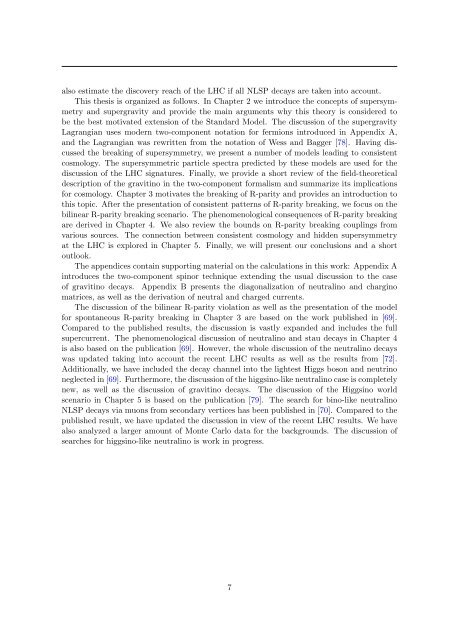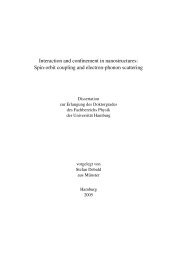Gravitinos and hidden Supersymmetry at the LHC - Universität ...
Gravitinos and hidden Supersymmetry at the LHC - Universität ...
Gravitinos and hidden Supersymmetry at the LHC - Universität ...
You also want an ePaper? Increase the reach of your titles
YUMPU automatically turns print PDFs into web optimized ePapers that Google loves.
also estim<strong>at</strong>e <strong>the</strong> discovery reach of <strong>the</strong> <strong>LHC</strong> if all NLSP decays are taken into account.<br />
This <strong>the</strong>sis is organized as follows. In Chapter 2 we introduce <strong>the</strong> concepts of supersymmetry<br />
<strong>and</strong> supergravity <strong>and</strong> provide <strong>the</strong> main arguments why this <strong>the</strong>ory is considered to<br />
be <strong>the</strong> best motiv<strong>at</strong>ed extension of <strong>the</strong> St<strong>and</strong>ard Model. The discussion of <strong>the</strong> supergravity<br />
Lagrangian uses modern two-component not<strong>at</strong>ion for fermions introduced in Appendix A,<br />
<strong>and</strong> <strong>the</strong> Lagrangian was rewritten from <strong>the</strong> not<strong>at</strong>ion of Wess <strong>and</strong> Bagger [78]. Having discussed<br />
<strong>the</strong> breaking of supersymmetry, we present a number of models leading to consistent<br />
cosmology. The supersymmetric particle spectra predicted by <strong>the</strong>se models are used for <strong>the</strong><br />
discussion of <strong>the</strong> <strong>LHC</strong> sign<strong>at</strong>ures. Finally, we provide a short review of <strong>the</strong> field-<strong>the</strong>oretical<br />
description of <strong>the</strong> gravitino in <strong>the</strong> two-component formalism <strong>and</strong> summarize its implic<strong>at</strong>ions<br />
for cosmology. Chapter 3 motiv<strong>at</strong>es <strong>the</strong> breaking of R-parity <strong>and</strong> provides an introduction to<br />
this topic. After <strong>the</strong> present<strong>at</strong>ion of consistent p<strong>at</strong>terns of R-parity breaking, we focus on <strong>the</strong><br />
bilinear R-parity breaking scenario. The phenomenological consequences of R-parity breaking<br />
are derived in Chapter 4. We also review <strong>the</strong> bounds on R-parity breaking couplings from<br />
various sources. The connection between consistent cosmology <strong>and</strong> <strong>hidden</strong> supersymmetry<br />
<strong>at</strong> <strong>the</strong> <strong>LHC</strong> is explored in Chapter 5. Finally, we will present our conclusions <strong>and</strong> a short<br />
outlook.<br />
The appendices contain supporting m<strong>at</strong>erial on <strong>the</strong> calcul<strong>at</strong>ions in this work: Appendix A<br />
introduces <strong>the</strong> two-component spinor technique extending <strong>the</strong> usual discussion to <strong>the</strong> case<br />
of gravitino decays. Appendix B presents <strong>the</strong> diagonaliz<strong>at</strong>ion of neutralino <strong>and</strong> chargino<br />
m<strong>at</strong>rices, as well as <strong>the</strong> deriv<strong>at</strong>ion of neutral <strong>and</strong> charged currents.<br />
The discussion of <strong>the</strong> bilinear R-parity viol<strong>at</strong>ion as well as <strong>the</strong> present<strong>at</strong>ion of <strong>the</strong> model<br />
for spontaneous R-parity breaking in Chapter 3 are based on <strong>the</strong> work published in [69].<br />
Compared to <strong>the</strong> published results, <strong>the</strong> discussion is vastly exp<strong>and</strong>ed <strong>and</strong> includes <strong>the</strong> full<br />
supercurrent. The phenomenological discussion of neutralino <strong>and</strong> stau decays in Chapter 4<br />
is also based on <strong>the</strong> public<strong>at</strong>ion [69]. However, <strong>the</strong> whole discussion of <strong>the</strong> neutralino decays<br />
was upd<strong>at</strong>ed taking into account <strong>the</strong> recent <strong>LHC</strong> results as well as <strong>the</strong> results from [72].<br />
Additionally, we have included <strong>the</strong> decay channel into <strong>the</strong> lightest Higgs boson <strong>and</strong> neutrino<br />
neglected in [69]. Fur<strong>the</strong>rmore, <strong>the</strong> discussion of <strong>the</strong> higgsino-like neutralino case is completely<br />
new, as well as <strong>the</strong> discussion of gravitino decays. The discussion of <strong>the</strong> Higgsino world<br />
scenario in Chapter 5 is based on <strong>the</strong> public<strong>at</strong>ion [79]. The search for bino-like neutralino<br />
NLSP decays via muons from secondary vertices has been published in [70]. Compared to <strong>the</strong><br />
published result, we have upd<strong>at</strong>ed <strong>the</strong> discussion in view of <strong>the</strong> recent <strong>LHC</strong> results. We have<br />
also analyzed a larger amount of Monte Carlo d<strong>at</strong>a for <strong>the</strong> backgrounds. The discussion of<br />
searches for higgsino-like neutralino is work in progress.<br />
7

















